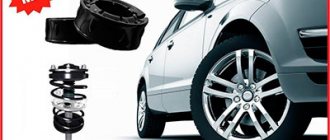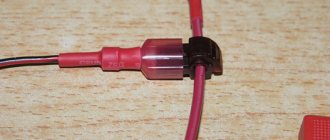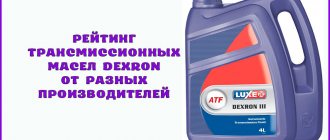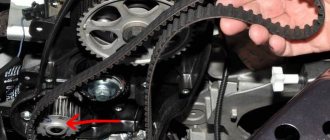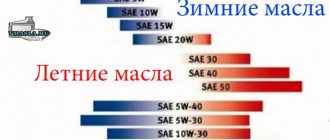Hydraulic power steering is designed to make steering easier, as well as dampen vibrations and shocks that occur on the steering wheel. In order for it to last a long time and work stably, it is necessary to regularly change the oil in it and monitor its quality. The article discusses Dextron oils, including Dextron 3 for power steering, and gives their description, advantages and disadvantages.
Description of the liquid
The power steering design consists of several mechanisms, which are visible in the diagram.
Power steering diagram for cars
The entire mechanism is washed by a special hydraulic fluid (PSF).
It has the following functions:
- transmits pressure from the pump to the piston;
- has a lubricating effect;
- has anti-corrosion properties;
- cools the components and mechanisms of the unit.
Thanks to the power steering oil, which circulates in a closed circuit, the created pressure is transferred from the pump to other components of the unit. When high pressure is created in the pump, PSF enters the low pressure zone where the SGC pistons are located. The cylinder is connected to the steering wheel rack using a spool. Depending on the position of the steering wheel, the spool directs oil, making it easier to turn the steering wheel.
An important function of PSF is to remove excess heat from mechanisms. In addition, acting as a lubricant, it reduces friction between moving components. Anti-corrosion additives in the composition prevent rust from forming inside the mechanism.
Compound
PSFs are divided into three types:
- mineral;
- semi-synthetic;
- synthetic.
Mineral ones contain 97% naphthenes and paraffins, the rest are additives that impart certain properties. Semi-synthetics contain both mineral and synthetic components. They have a longer service life and better performance. Synthetic PSF contains polyesters, hydrocracked petroleum fractions, and polyhydric alcohols. In addition, they contain additives that improve its properties.
PSF contains the following additives:
- to reduce friction between parts;
- against corrosion processes;
- viscosity stabilizing;
- acidity stabilizing;
- giving color;
- preventing foaming;
- to protect rubber parts.
When choosing power steering oil, you should pay attention to the composition and technical characteristics (video author - Vladislav Chikov).
Advantages and disadvantages
Each type of working fluid has its own advantages and disadvantages:
| Type PSF | Advantages | Flaws |
| Mineral |
| |
| Semi-synthetic |
| |
| Synthetic |
|
Dextron red
Interchangeability and miscibility
The manufacturer introduced the qualification of power steering fluids by color by adding coloring pigments to their composition: red, yellow and green. Red power steering oils are developed according to General Motors standards; they are called Dextrons.
Classification of hydraulic fluids
The main function of power steering fluid is to transfer the pressure generated by the pump to the piston of the hydraulic cylinder. In addition, it helps ensure cooling and lubrication of all components and mechanisms of the reinforcement system, protecting them from destructive corrosive processes.
Many drivers, faced with the choice and purchase of this type of oil fluid for the first time, are quite expectedly confused, since any store offers at least 5-10 formulations that differ from each other in the following characteristics:
- mechanical properties;
- viscosity;
- chemical composition;
- hydraulic properties;
- temperature characteristics.
The simplest option for selecting oil for power steering is to use its color gradation.
Color classification
Depending on the color, on the modern market of technical fluids for vehicles there are three types of oil in power steering 0: red, yellow and green.
Red
Red hydraulic fluid is a development of the General Motors brand, which specializes in the production of synthetic and mineral oils. The most well-known mineral compounds in this color category are Dexron II and Dexron III, while popular synthetic fluids include ATF and its derivatives.
A distinctive feature of red oil for power steering is the presence in its composition of impurities intended for the automatic transmission clutch. These additives do not affect the operation of the power steering itself. Moreover, in some Asian countries, in principle, there is no separation of oil fluid into hydraulic and transmission.
Red oil is usually recommended for use in cars made in America, Europe, Japan and Korea.
Yellow
Yellow oil fluids can also be synthetic and mineral. The former can be filled not only into power steering, but also used in hydraulic suspension, while the latter are intended for use only in the power steering system.
The main manufacturer of yellow power steering mineral oil is Daimler AG. In most cases, these fluids are used in business and premium class cars - Mercedes-Benz, Maybach, etc.
Yellow synthetics are mainly represented by brands such as Total and Mobil. Most often it can be found in Citroen and some other cars of European manufacturers.
Green
Green power steering fluids, regardless of whether we are talking about synthetic or mineral oil, are intended exclusively for use in the power steering system.
On the domestic market, the most popular and affordable green power steering fluid is VAG products. It is widely used in cars such as: Volkswagen, Skoda, Scania, Porsche, Audi, etc.
Some automakers have their own lines of oil. For example, Mercedes-Benz produces green mineral water for power steering, while BMW produces first-class synthetics under the Pentosin brand.
Types of oils
The composition of power steering oils is not much different in composition from any other technical fluids for vehicles. For their production, a mineral or synthetic oil base is used. To give the finished composition certain characteristics and functions, various additives are added to it: extreme pressure, anti-corrosion, anti-foam, reducing the wear rate of components and mechanisms, preventing oxidative processes in the hydraulic booster system.
Synthetics
Synthetic PSF (abbr. Power Steering Fluid, literally translated as power steering fluid) are modern, highly effective formulations that use innovative additives. For example, petroleum fractions undergo multi-stage purification by hydrocracking, and polyhydric alcohols, polyester substances and other artificial components are enriched with various additives that give the finished fluid useful characteristics, such as increased service life of the oil fluid, immunity to temperature changes, etc.
Before purchasing synthetics from GUR, you should make sure that it is suitable for use on your car. The fact is that compositions of this type have an extremely aggressive effect on the rubber elements of the machine’s hydraulics. Also, when choosing, you should take into account the compatibility of synthetic power steering oil with mineral fluids.
As a rule, synthetics are recommended for cars of the following brands: Nissan, Mazda, Toyota, Kia, Honda, etc.
Semi-synthetics
Semi-synthetic oil is a kind of intermediate option, which combines all the “strongest” qualities of mineral and synthetic compounds: excellent anti-corrosion properties, reduced foaming, excellent fluidity, etc. However, semi-synthetics also have their disadvantages. In particular, the presence of synthetic components in its composition causes the destructive effect of the oil on rubber parts and components of the hydraulic system.
An excellent option for power steering fluid for Toyota, Honda or Mazda would be the following semi-synthetic compounds: MotulDexron III, Zic ATF Dex 3 and Comma PSF MVCHF. If we talk about cost, then buying semi-synthetics will cost slightly less than synthetic oils, but more expensive than mineral ones.
Mineralka
Products for the production of which mineral compounds are used have the following composition: 85-98% of the liquid is purified petroleum fractions, the remaining 15-2% are various additives designed to improve the overall characteristics of hydraulic oil. Unlike synthetics, mineral water does not have any impact on power steering structural elements made of rubber.
An important advantage of mineral oils is their relatively low cost. Speaking about the disadvantages, it is necessary to note the relatively short service life of the fluid, which in turn reduces the period of its replacement. Many drivers also note that hydraulic mineral water causes many problems with increased foaming and high viscosity, which negatively affects the efficiency of the entire reinforcement system.
Popular products from this category of technical fluid are the compositions Dextron 2 and 3, Mobile ATF 320 Premium.
The difference between Dexron 2E (IIE) and 2D (IID)
Most of the world's manufacturers of ATF and automatic transmission oils are guided by the General Motors fluid quality specification. Since the eighties, GM's current standard has been Dextron IID, which was later updated to Dexron IIE. And already in 1993, the standardization of Dextron No. 3 entered the market.
The differences between Dexron IIE and Dexron IID are minor. However, the new generation of Dextron number 3 standards differs significantly from its predecessors. The fractional characteristics of the third generation mixture have significantly improved, the manifestation of which affects all operating modes of the automatic transmission.
All generations of Dextron specifications are considered interchangeable. However, it is possible to update the gear oil only to a new generation; the opposite actions will worsen the performance of the additives that are added to Dexron 3 mixtures.
You should not replace Dexron 2 with Dexron 3 in cases where the manufacturer of the corresponding transmission does not declare an increase in efficiency when moving to new standards.
What kind of oil to pour into the power steering
Most often, car owners distinguish power steering solely by color - red, green and yellow. But its other characteristics are much more important:
- Kinetic viscosity
- Operating temperatures
- The raw materials from which it is made
Red products are made on a synthetic basis, very rarely on a mineral basis. These mixtures are included in the ATP and are used on a limited number of models. Mineral red oil is often a Dexron 2 and Dexron 3 . Red compounds are poured into transmissions; Dextron is rarely used in power steering.
Yellow oil is made on a mineral base, this makes the cost of products more affordable. The yellow hydraulic mixture is used in both hydraulic boosters and air suspension.
The green mixture can be made from both synthetic and mineral components. It is more viscous than yellow and red. Green lubricant is never poured into an automatic transmission.
Related material: How to change power steering oil on a Hyundai Solaris?
find out which oil is suitable for a particular model in the car’s owner’s manual or on the top of the expansion tank cap. The manual contains recommended parameters and the name of the composition, the same information is usually written on the lid.
Popular brands specifications
Mannol Dexron 3
Mannol Dexron 3 automatic is considered a multi-purpose oil for automatic transmissions. This Manol mixture is also used in power steering, hydraulic clutches, and spinning mechanisms.
Just like all, without exception, Dextron oils have a reddish tone. The manufacturer has worked hard on the combination of additives and synthetic components, the components of which help improve the fractional characteristics at the time of gear shifting.
Oil from a manufacturer in Germany has high low-temperature characteristics, excellent antioxidant properties, and stable chemical composition throughout the entire period of operation. It is not advisable to use copper elements as a lubricant; the liquid is absolutely neutral to all other alloys and materials.
The products have all possible tolerances:
- ZF-TE-ML 09/11/14, ALLISON C4/TES 389, GM DEXR. III H/G/F, FORD M2C138-CJ/M2C166-H and others.
Castrol DEXRON
Castrol DEXRON is a low-viscosity mixture for automatic transmissions and is designed for use in modern gearboxes. It has proven itself to be the mixture with the greatest fuel economy.
Castrol production is established in Germany. The oil consists of high-quality base mixtures with an optimal set of additives. Has positive feedback from GM and Ford management, exceeds the requirements of the Japanese JASA 1A specification. In cases where it is not possible to purchase Dextron ATF for the Japanese, you can safely use oil from Castrol - Dexron 6.
Which power steering fluid to choose in 2022
When choosing hydraulic products, you should be guided by the chemical composition and operating conditions of the products. The best hydraulic oils are presented in this selection. Each of these products meets quality standards and has excellent characteristics in its class.
It is necessary to select a hydraulic product taking into account the recommendations of the car manufacturer, but you can easily replace the original oil with a similar one from the TOP 20 best.
Operating conditions for Dexron 3
Historically, you should not rely on the tolerances of mixtures from manufacturing companies. All reputable car enthusiasts recommend paying attention to the specifications from the GM concern and the standards from automatic transmission manufacturers.
The main preconditions that you can focus on are the designations of the “transmission” on the automatic transmission dipstick. If so, it is preferable to fill it. Otherwise, the consequences could be dire.
Our advice: Follow the recommendations of the automatic transmission manufacturers of your car, follow the standards from General Motors, fill in the acceptable transmission mixture, and replace it in a timely manner. And your transmission will serve you long and reliably.
Interesting video
What kind of fluid should I put in the power steering Dexron III ATF Multi HF? This question worries many beginners, as well as quite experienced drivers! The thing is that, as such, specialized fluids for power steering are very difficult to find on the automotive market, so according to advice from forums or friends, pour the following into the power steering fluid reservoir:
- Dexron (II - VI), the same as ATP liquid, only a different set of additives;
- PSF (I - IV);
- regular ATF, as in an automatic transmission;
- Multi HF.
As part of this article, I will give you a rating of the best power steering fluids 2022 - 2022 according to drivers, and you yourself will be able to choose the highest quality product for yourself at the best price.
Rating of power steering fluids 2022 - 2022 in tables
Automatic transmission oils (ATF), when filled into the power steering, have the same functions as power steering fluids, the function of increasing the static friction of the clutches (depending on the material of the clutches) and the function of reducing friction wear.
Rating of ATF fluids for power steering 2022 – 2019
| 1 | Formula Shell Multi-Vehicle ATF | from 360 rub. |
| 2 | Motul Multi ATF | from 800 rub. |
| 3 | ZIC ATF III | from 400 rub. |
| 4 | Mobil ATF 320 Premium | from 400 rub. |
| 5 | Liqui Moly Top Tec ATF 1100 | from 350 rub. |
The best power steering fluids (PSF)
If you intend to fill the power steering with PSF fluid, then you will need to consider the following: the fluid acts as a working fluid that transmits pressure from the pump to the piston, a lubricating function, an anti-corrosion function, and heat transfer to cool the system.
| Place | Name/Price | |
| 1 | RAVENOL Hydraulik PSF Fluid | from 1100 rub. |
| 2 | Pentosin CHF 11S | from 800 rub. |
| 3 | Motul Multi HF | from 600 rub. |
| 4 | Comma PSF MVCHF | from 500 rub. |
| 5 | LIQUI MOLY Zentralhydraulik-Oil | from 1000 RUR |
The best power steering fluids Dextron
The Dexron family was originally developed for use as hydraulic oils in automatic transmissions. Therefore, sometimes these oils are called transmission oils, which creates confusion, since transmission oils used to mean thick oils of the GL-5, GL-4, TAD-17, TAP-15 brands for gearboxes and rear axles with hypoid gears. Hydraulic oils are much thinner than transmission oils. It's better to call them ATPs. ATF stands for Automatic Transmission Fluid (literally - Fluid for automatic transmissions - i.e. automatic transmissions)
| 1 | Mannol Dexron III Automatic Plus | from 550 rub. |
| 2 | ENEOS Dexron ATF III | from 450 rub. |
| 3 | Castrol Transmax DEX-VI | from 220 rub. |
| 4 | Motul DEXRON III | from 600 rub. |
| 5 | Febi 32600 DEXRON VI | from. 400 rub. |
What is better for power steering: mineral oils or synthetics
The long-standing debate about which is better - synthetic or mineral water for the power steering system is not appropriate. The fact is that in the power steering there are a lot of rubber parts like nowhere else. Synthetic oils have a worse effect on the life of rubber parts based on natural rubber (almost all types of rubber), due to their chemical aggressiveness. In order to fill synthetic oils into the power steering system, its rubber parts must be designed for synthetic oils and have a special composition.
«>
Changing the power steering oil
If the power steering mechanism works properly and without leaks, the composition needs to be changed every 1-2 years , depending on the manufacturer’s instructions. Periodically you need to check the fluid level; it should be between the minimum and maximum marks.
Adding fluid
The lubricant in the power steering can gradually evaporate due to high temperatures in the system. If during the service interval some of the mixture has left the power steering system, you can add the required amount. To do this, open the expansion tank, fill the product up to the MAX mark, turn the steering wheel, pump the system and, if necessary, add more.
Complete replacement
You can change the power steering oil using two jacks, a syringe and a container for waste material.
- The front of the car must be raised so that the wheels are in the air.
- Open the expansion tank and use a syringe to pump out the bulk of the old mixture.
- Next, you need to remove the main hose from the pump, it is usually located below, and lower it into a container to drain.
- Turn the steering wheel to bleed the mechanism, wait for it to drain and put the hose in place.
- Remove the return hose, lower it into the same container, pump it and install it back.
- The engine must be turned off during this procedure.
When the used material is completely drained, fresh material can be poured in. Pour in up to the maximum mark, pump the mechanism by turning the steering wheel. Part of the composition will leave the tank into the system; you need to top it up again. It is necessary to pump and top up several times until the entire power steering mechanism is filled and the oil is at the same level.


